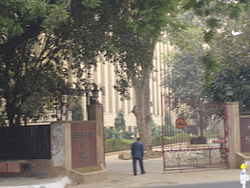Reserve Bank of India: Difference between revisions
Johnian144 (talk | contribs) No edit summary |
Unsolicited (talk | contribs) |
||
| Line 163: | Line 163: | ||
== External links == |
== External links == |
||
* [http://www.rbi.org.in/ Reserve Bank of India Official site] |
* [http://www.rbi.org.in/ Reserve Bank of India Official site] |
||
* [http://www.rbi.org.in/Scripts/bs_viewcontent.aspx?Id=159 Reserve Bank of India Ombudsman site] |
|||
* [http://www.livejournal.com/users/true_it_is/1232.html Reforms on the mandate of RBI] |
* [http://www.livejournal.com/users/true_it_is/1232.html Reforms on the mandate of RBI] |
||
Revision as of 12:39, 4 July 2006



The Reserve Bank of India (RBI) is the central bank of India, and was established on April 1, 1935 in accordance with the provisions of the Reserve Bank of India Act, 1934. Since its inception, it has been headquartered in Mumbai. Though originally privately owned, RBI has been fully owned by the Government of India since nationalization in 1949.
RBI is governed by a central board (headed by a Governor) appointed by the Central Government. The current governor of RBI is Dr.Y.Venugopal Reddy (who succeeded Dr. Bimal Jalan on September 6, 2003). RBI has 22 regional offices across India.
The Reserve Bank of India was set up on the recommendations of the Hilton Young Commission. The commission submitted its report in the year 1926, though the bank was not set up for nine years.
On June 27,2006,the Union Government of India reconstituted the Central Board of Directors of the Reserve Bank of India (RBI) with 13 members, including Azim Premji and Kumar Mangalam Birla.
The other members of the board are:
- Suresh Tendulkar, Economist and Member, Prime Minister's Economic Advisory Council (to represent Eastern Area Local Board)
- U. R. Rao, former Chairman, ISRO and Chairman Research Council, Physical Research Laboratory, Department of Space (to represent Northern Area Local Board)
- Lakshmi Chand, IAS (Retd.) (to represent Southern Area Local Board)
- Shashi Rekha Rajagopalan, Consultant, Co-operatives
- Suresh Kumar Neotia, Chairman, Ambuja Cement
- A. Vaidyanathan, Madras Institute of Development Studies
- Man Mohan Sharma, FRS, Former Director, Mumbai University Institute of Chemical Technology
- D. Jayavarthanavelu, Chairman and Managing Director, Laxmi Machine Works Ltd.
Those who were renominated to the board include
- Y. H. Malegam, Chartered Accountant, (to represent Western Area Local Board),
- H. P. Ranina, Supreme Court Advocate,
- Ashok S. Ganguly, Member, Investment Commission and Chairman, ICICI OneSource.
The retiring Directors include
Mr Ratan Tata
On 1 July,2006 in an attempt to enhance the quality of customer service and strengthen the grievance redressal mechanism, the Reserve Bank of India constituted a new department — Customer Service Department (CSD).
Main objectives
- Monetary Authority:
- Formulates, implements and monitors the monetary policy.
- Objective: maintaining price stability and ensuring adequate flow of credit to productive sectors.
- Regulator and supervisor of the financial system:
- Prescribes broad parameters of banking operations within which the country's banking and financial system functions.
- Objective: maintain public confidence in the system, protect depositors' interest and provide cost-effective banking services to the public.
- Manager of Exchange Control:
- Manages the Foreign Exchange Management Act, 1999.
- Objective: to facilitate external trade and payment and promote orderly development and maintenance of foreign exchange market in India.
- Issuer of currency:
- Issues and exchanges or destroys currency and coins not fit for circulation.
- Objective: to give the public adequate quantity of supplies of currency notes and coins and in good quality.
- Developmental role
- Performs a wide range of promotional functions to support national objectives.
- Related Functions
- Banker to the Government: performs merchant banking function for the central and the state governments; also acts as their banker.
- Banker to banks: maintains banking accounts of all scheduled banks.
- Owner and operator of the depository (SGL) and exchange (NDS) for government bonds.
There is now an international consensus about the need to focus the tasks of a central bank upon central banking. RBI is far out of touch with such a principle, owing to the sprawling mandate described above.
Major Liabilities of Commercial Banks
Figures below are in millions of Indian Rupees. See [1] and [2]
| Year | Deposits and other AccountsTemplate:Fn | Bills Payable |
|---|---|---|
| 1950 | 9,983 | 173 |
| 1955 | 11,592 | 262 |
| 1960 | 20,218 | 317 |
| 1965 | 32,897 | 446 |
| 1970 | 64,793 | 923 |
| 1975 | 156,665 | 2,254 |
| 1980 | 439,869 | 10,995 |
| 1985 | 1,032,134 | 24,556 |
| 1990 | 1,820,468 | 38,656 |
| 1995 | 3,984,352 | 116,622 |
| 2000 | ||
| 2005 |
Major Assets of Commercial Banks
Figures below are in millions of Indian Rupees. See [3] and [4]
| Year | InvestmentsTemplate:Fn | AdvancesTemplate:Fn |
|---|---|---|
| 1950 | 4,330 | 5,353 |
| 1955 | 4,600 | 7,037 |
| 1960 | 7,241 | 12,458 |
| 1965 | 9,884 | 21,954 |
| 1970 | 18,148 | 46,850 |
| 1975 | 45,999 | 106,167 |
| 1980 | 126,642 | 272,673 |
| 1985 | 303,378 | 623,553 |
| 1990 | 687,151 | 1,095,412 |
| 1995 | 1,750,206 | 2,243,308 |
| 2000 | ||
| 2005 |
Foot Notes
- Template:Fnb - include fixed, savings, current, contingency accounts, et al
- Template:Fnb - include securities of Central and States governments, trustee securities, shares, debentures, gold, et al
- Template:Fnb - include loans and advances, cash credit and overdrafts, bills purchased and discounted
